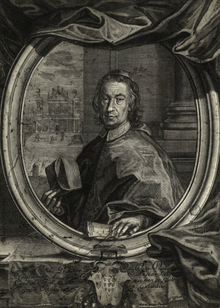Nuno da Cunha e Ataíde
Nuno da Cunha de Ataíde e Melo (7 December 1664 – 3 December 1750), more commonly referred to as Cardinal da Cunha, was a Portuguese Cardinal of the Catholic Church, and a politically important figure as a close advisor to King John V. Cardinal da Cunha occupied several positions at Court, as the King's chief chaplain, a chief minister ("ministro do despacho") and a significant member of the Council of State; he is perhaps most well-remembered as the Inquisitor-General of the Tribunal of the Holy Office from 1707 until his death in 1750.
Nuno da Cunha e Ataíde | |
|---|---|
| Cardinal, Titular Bishop of Targa Inquisitor-General of Portugal | |
 | |
| Other posts | Cardinal-Priest of Sant'Anastasia al Palatino |
| Orders | |
| Consecration | 14 March 1706 by Álvaro de Abranches e Noronha |
| Created cardinal | 18 May 1712 by Pope Clement XI |
| Rank | Cardinal-Priest |
| Personal details | |
| Born | 7 December 1664 São José, Lisbon, Portugal |
| Died | 3 December 1750 (aged 85) Santa Justa, Lisbon, Portugal |
| Nationality | Portuguese |
| Denomination | Roman Catholic |
| Previous post | Bishop of Elvas (1705) |
| Signature | |
| Coat of arms |  |
Biography
Nuno da Cunha was born in the parish of São José in Lisbon,[1][2] the son of Luís da Cunha e Ataíde, 9th Lord of Povolide (1619-1672), and his wife D. Guiomar de Lencastre (1631-1665). His eldest brother, Tristão da Cunha Ataíde (1655-1728) would later be created 1st Count of Povolide. He studied at the University of Coimbra, first Theology, but then switched to Canon Law, in which he earned his degree.[3]
He was first a canon of the Diocese of Coimbra, but soon afterwards started his career within the Inquisition, first in Coimbra and then in Lisbon. King Peter II appointed Nuno da Cunha as his chaplain of honour (sumilher da cortina) and, in 1702, made him a member of the Council of the Three Estates (Junta dos Três Estados). In 1705 he was made the King's chief chaplain and was nominated Bishop of Elvas, but refused this latter appointment: he was instead consecrated Titular Bishop of Targa (in the Ancient Roman province of Africa Proconsularis) the following year.[3] After the death of Peter II and the accession of his son King John V (in whose education Nuno da Cunha had played a part[4]), he was offered several more positions of political importance at Court. In 1707, he was made Inquisitor-General of Portugal and, in 1712, Cardinal-Priest of Sant'Anastasia al Palatino.

.jpg)
Following the death of Pope Clement XI in 1721, he was summoned to that year's papal conclave. He departed Lisbon on 9 May aboard a Portuguese carrack; arriving at the port of Leorne on 19 May, he received news that Cardinal Michelangelo dei Conti had already been elected pope, as Innocent XIII. He was subsequently received in Rome with "special demonstrations of paternal benevolence" by the new Pontiff (who already knew Nuno da Cunha from his time as Apostolic Nuncio to Portugal from 1698 to 1706). During his time in Rome, Cardinal da Cunha was occupied in several assignments with the Congregations for Bishops, for Regulars, for the Propagation of the Faith, for Rites, and for Consistorial Provisions.[3] Also during this time, he sponsored major works at great personal expense on his titular church of Sant'Anastasia al Palatino.
He only arrived back in Portugal on October 1722, having travelled by land and stopping on places of pilgrimage along the way. In Ancona, he made two precious offerings to Our Lady of Loreto ("a large golden cross, set with thick sapphires surrounded by diamonds", and "a precious ornament of gold over lapis lazuli and decorated with hieroglyphs, to adorn the niche").[3] On 3 June 1722, a rare private ostension of the Shroud of Turin was held for Cardinal da Cunha at the Chapel of the Holy Shroud.[5]
After his death, according to the official gazette, Cardinal da Cunha's body was dissected and embalmed by two surgeons using a new technique: the procedure took seven and a half hours. He was interred, following his own instructions, in the Chapter House of the Monastery of Saint Dominic in Lisbon, under a plain ledger stone.[2]
References
- Livro de Registo de Baptismos 1632/1673 (f. 212 v.), Paróquia de São José, Lisboa – Arquivo Nacional da Torre do Tombo
- "Portugal. Lisboa 22 de Dezembro". Gazeta de Lisboa (in Portuguese). No. 51. 22 December 1750. pp. 1010–1012. Retrieved 27 March 2020.
- Sousa, D. António Caetano (1745). Historia Genealogica da Casa Real Portugueza (in Portuguese). XI. Lisbon: Regia Officina Sylviana. pp. 272–281.
- Cunha, D. Luís da (1930). Instruções inéditas de D. Luis da Cunha a Marco António de Azevedo Coutinho, revistas por Pedro de Azevedo e prefaciadas por António Baião (in Portuguese). Coimbra: Imprensa da Universidade.
- Merlotti, Andrea. "The Holy Shroud between the Court of Savoy and the City of Turin: The Ostensions from the Seventeenth to Nineteenth Century (1630–1831)". The Shroud at Court: History, Usages, Places and Images of a Dynastic Relic. Leiden, The Netherlands: Koninklijke Brill. p. 147. ISBN 978-90-04-39050-8.
| Catholic Church titles | ||
|---|---|---|
| Preceded by Bernardinus a San Antonio |
Titular Bishop of Targa 1705–1721 |
Succeeded by Agostino Nicola degl'Abbati Olivieri |
| Preceded by José de Lencastre |
Inquisitor-General of Portugal 1707–1750 |
Succeeded by Joseph of Braganza |
| Preceded by Giandomenico Paracciani |
Cardinal-Priest of Sant'Anastasia al Palatino 1712–1750 |
Succeeded by Carlo Maria Sacripante |